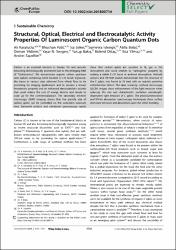| dc.contributor.author | Karatutlu, Ali | en_US |
| dc.contributor.author | Patil, Bhushan | en_US |
| dc.contributor.author | Şeker, İsa | en_US |
| dc.contributor.author | İstengir, Sümeyra | en_US |
| dc.contributor.author | Bolat, Atilla | en_US |
| dc.contributor.author | Yıldırım, Osman | en_US |
| dc.contributor.author | Sevgen, Yaşar N. | en_US |
| dc.contributor.author | Bakış, Yakup | en_US |
| dc.contributor.author | Ortaç, Bulend | en_US |
| dc.contributor.author | Yılmaz, Eda | en_US |
| dc.contributor.author | Sapelkin, Andrei | en_US |
| dc.date.accessioned | 2019-05-29T12:00:19Z | |
| dc.date.available | 2019-05-29T12:00:19Z | |
| dc.date.issued | 2018-05-08 | |
| dc.identifier.citation | Karatutlu, A., Patil, B., Seker, I., Istengir, S., Bolat, A., Yildirim, O., . . . Sapelkin, A. (2018). Structural, Optical, Electrical and Electrocatalytic Activity Properties Of Luminescent Organic Carbon Quantum Dots. Chemistryselect, 3(17), 4730-4737. doi:10.1002/slct.201800714 | en_US |
| dc.identifier.issn | 2365-6549 | |
| dc.identifier.uri | https://hdl.handle.net/20.500.12294/1426 | |
| dc.description | Bolat, Atilla (Arel Author), Yıldırım, Osman (Arel Author) | en_US |
| dc.description.abstract | Carbon is an essential element in human life and recently becoming technologically prominent due to the emerging field of "Carbononics". We demonstrate organic carbon quantum dots (qdots) containing nitrile bonded (C N bond) d-glucose-like traces in various sizes obtained from wheat flour to be promising for imaging applications and to possess a relaxor ferroelectric property and an enhanced electrocatalytic activity that could reduce the cost of energy devices and simple to scale up for the commercialization. The secondary electron microscopy (SEM) imaging shows that the particle size of carbon qdots can be controlled via the sonication exposure time. Elemental analysis and vibrational spectroscopy results show that carbon qdots are sensitive to N-2 gas in the atmosphere and could weaken its "carbogenic" property by making a stable C N bond at ambient atmosphere. Rietveld analysis and HR-TEM studies demonstrate that the structure of the C qdots was found to fit best with an acentric primitive orthorhombic lattice. The laser scanning confocal microscopy (LSCM) images show enhancement of the light emission when reducing the size and characteristic excitation wavelength-dependent light emission of C qdots. The photoluminescence and UV-Vis absorption spectroscopy techniques show surface dominant emission and absorption upon the nitrile bonding. | en_US |
| dc.language.iso | eng | en_US |
| dc.publisher | Wiley | en_US |
| dc.relation.ispartof | Chemistryselect | en_US |
| dc.identifier.doi | 10.1002/slct.201800714 | en_US |
| dc.identifier.doi | 10.1002/slct.201800714 | |
| dc.rights | info:eu-repo/semantics/openAccess | en_US |
| dc.subject | Carbon | en_US |
| dc.subject | Catalytic Activity | en_US |
| dc.subject | Ferroelectric | en_US |
| dc.subject | Organic | en_US |
| dc.subject | Quantum Dots | en_US |
| dc.title | Structural, Optical, Electrical and Electrocatalytic Activity Properties Of Luminescent Organic Carbon Quantum Dots | en_US |
| dc.type | article | en_US |
| dc.department | İstanbul Arel Üniversitesi, Mühendislik ve Mimarlık Fakültesi, Elektrik-Elektronik Mühendisliği Bölümü | en_US |
| dc.identifier.volume | 3 | en_US |
| dc.identifier.issue | 17 | en_US |
| dc.identifier.startpage | 4730 | en_US |
| dc.identifier.endpage | 4737 | en_US |
| dc.relation.publicationcategory | Makale - Uluslararası Hakemli Dergi - Kurum Öğretim Elemanı | en_US |


















